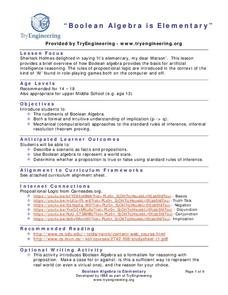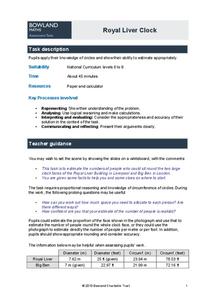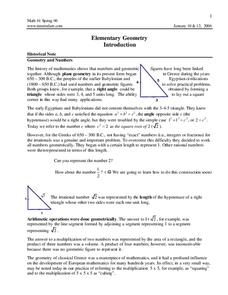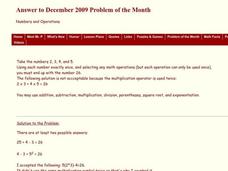Curated OER
Is it alive?
Kids in grades K-2 increase their logical reasoning and visual discrimination skills by determining which things shown are alive. They use the criteria that all living things move on their own to mark each image as alive or not.
Center for Mathematics and Technology
Whole Numbers: Using an Area Model to Explain Multiplication
There are many ways to work through a multiplication problem. Using an area model, kids complete several worksheets with different types of multiplication problems, including multiplying by ten, and explain how the new strategies differ...
Virginia Department of Education
Logic and Conditional Statements
If there is a conditional statement, then there is a hypothesis and conclusion. Pupils learn how to identify the parts of conditional statements. Class members continue to work with conditional statements and rewrite them in their many...
TryEngineering
Boolean Algebra is Elementary
See how Boolean algebra relates to video games with a lesson that teaches young scholars how to use Boolean algebra to create rules for a virtual world. They test the rule base for consistency in groups.
Education Development Center
Thinking Things Through Thoroughly
Problem solving is a skill of its own. Learners use a variety of problems to encourage mental math and logic to get the correct answer. Guiding questions are provided along the way to encourage the right way of thinking to help tackle...
Math Stars
Math Stars: A Problem-Solving Newsletter Grade 6
Think, question, brainstorm, and make your way through a newsletter full of puzzles and word problems. The resource includes 10 different newsletters, all with interesting problems, to give class members an out-of-the box...
Curated OER
Basic Exercises in Logic
In this logic worksheet, students are taught about the use of syllogisms to solve problems. They use diagrams to visually show the relationships between objects. They complete two given syllogisms and answer questions about their results.
Curated OER
Use the Clues
In this reasoning worksheet, 2nd graders, after looking over the example, read 3 clues 3 times to find the 3 numbers that make each sum in 3 boxes.
Inside Mathematics
Quadratic (2006)
Most problems can be solved using more than one method. A worksheet includes just nine questions but many more ways to solve each. Scholars must graph, solve, and justify quadratic problems.
Curated OER
Connect the Animal to its Food
What kind of food does a monkey eat? If you know, then you'll be able to complete this learning exercise. To practice drawing a straight line, learners draw to connect the animal to its food. A total of five lines will be drawn from...
Bowland
Royal Liver Clock
Using clocks as dining tables? Scholars estimate the number of people that can sit around the face of the clock on the Royal Liver Building in Liverpool. They use estimation to justify their responses.
Curated OER
Number Line: Negative Numbers
In this graphing calculator worksheet for the TI-83 calculator, students first observe a demonstration for calculating negative numbers. Next, students use their graphing calculator to answer 6 thoughtful T/F and short answer...
Curated OER
The Grandchildren Problem
In this grandchildren problem, students read facts about grandchildren. They use logical reasoning to determine the birthday of four grandchildren. Students predict the date of the fifth grandchild's birth. This...
Curated OER
Problem of the Day #6: Logic
In this logic activity, students use logical reasoning to determine if given statements are true or false. This two-page activity contains twelve problems.
Mt. San Antonio Collage
Elementary Geometry
Your class may believe that geometry is a trial, but they don't know how right they are. A thorough math lesson combines the laws of logic with the laws of geometry. As high schoolers review the work of historical mathematicians and...
Curated OER
Missionaries and Cannibals
In this missionaries and cannibals worksheet, learners read a word problem and use logic and deductive reasoning to solve the problem. This one-page worksheet contains one problem. Answers are provided at the bottom of the page.
Math Stars
Math Stars: a Problem-Solving Newsletter Grade 7
Put on your thinking caps because middle school math has never been more interesting in this huge resource full of thought provoking questions. Written as a newsletter, the resource has 10 two-page newsletters with a variety of...
Savvas Learning
Putting Shapes in Order
Challenge math scholars with polygon word problems that require logical reasoning. They answer two word problems about geometric shapes and their arrangement in a column based on clues given. Next, learners draw a robot made of...
Curated OER
Trip Around the US
In this algebra worksheet, 11th graders are given a scenario and asked to solve using algebraic symbols and equations. They have to figure out how the boss knew what state would be Jack's last state to visit. A solution is provided.
Curated OER
Numbers and Operations
In this algebra worksheet, students solve a word problem using algebraic expressions. An answer key is provided.
Aurora City School District
Do Not Try to Kid a Kidder: The Art of Persuasion
The power to convince others of your argument lies in your knowledge of rhetoric! A thorough packet covers the basics of persuasion, including logical appeals and fallacies, and applies strategies to letters to the editor,...
Arizona Department of Education
Introduction to Integers
Welcome to the backward world of negative numbers. This introductory lesson teaches young mathematicians that negative numbers are simply the opposite of positive numbers as they use number lines to plot and compare...
Polk Bros Foundation
Contrast Points of View
Compare two positions on the same topic and assess the positions for logical argument with a basic worksheet. Pupils fill in information about each position, note down which position is more logical, and compose a few sentences...
Curated OER
Let's Line Up!
For this reasoning worksheet, 2nd graders use logical reasoning to determine what each person's place in line is. Students are given 4 questions to practice the skill.

























